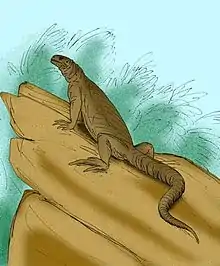| Yabeinosaurus Temporal range: Early Cretaceous | |
|---|---|
 | |
| Fossil of Y. tenuis, Beijing Museum of Natural History | |
| Scientific classification | |
| Domain: | Eukaryota |
| Kingdom: | Animalia |
| Phylum: | Chordata |
| Class: | Reptilia |
| Order: | Squamata |
| Informal group: | Scleroglossa (?) |
| Genus: | †Yabeinosaurus Endo and Shikama, 1942 |
| Type species | |
| †Yabeinosaurus tenuis Endo and Shikama, 1942 | |

Yabeinosaurus is an extinct genus of lizard from the Early Cretaceous Jehol Group of northeastern China. The type species Yabeinosaurus tenuis is known from many well-preserved skeletons belonging to both juvenile and adult individuals. For about 60 years Yabeinosaurus was known only from juvenile specimens, leading scientists to believe that it was a small lizard with weakly developed bones. Because of this, it was thought to be closely related to geckos. Larger specimens up to 35 centimetres (14 in) snout‐vent length.[1]
long were first described in 2005, showing that Yabeinosaurus was a relatively large lizard when fully grown. Recent phylogenetic analyses indicate that Yabeinosaurus is not closely related to geckos but rather a very basal ("primitive") lizard close to the split between Iguania and Scleroglossa, one of the earliest divergences in the evolutionary history of lizards. Whether or not it lies outside this split or within Scleroglossa is uncertain.[2]

In 2011 a fossil of Yabeinosaurus was discovered with 15 well-developed embryos inside it, making it the oldest fossil of a pregnant, viviparous (live-bearing) lizard yet discovered.[3][4]
References
- ↑ Evans, Susan E.; Wang, Yuan (2012-04-01). "New material of the Early Cretaceous lizard Yabeinosaurus from China". Cretaceous Research. 34: 48–60. doi:10.1016/j.cretres.2011.10.004. ISSN 0195-6671.
- ↑ Evans, S. E.; Wang, Y.; Li, C. (2005). "The early Cretaceous lizard genusYabeinosaurusfrom China: Resolving an enigma". Journal of Systematic Palaeontology. 3 (4): 319. doi:10.1017/S1477201905001641. S2CID 86410052.
- ↑ Wang, Y.; Evans, S. E. (2011). "A gravid lizard from the Cretaceous of China and the early history of squamate viviparity". Naturwissenschaften. 98 (9): 739–743. Bibcode:2011NW.....98..739W. doi:10.1007/s00114-011-0820-1. PMID 21766177. S2CID 8017857.
- ↑ Fossil 'is first pregnant lizard', BBC Nature, 21 July 2011
